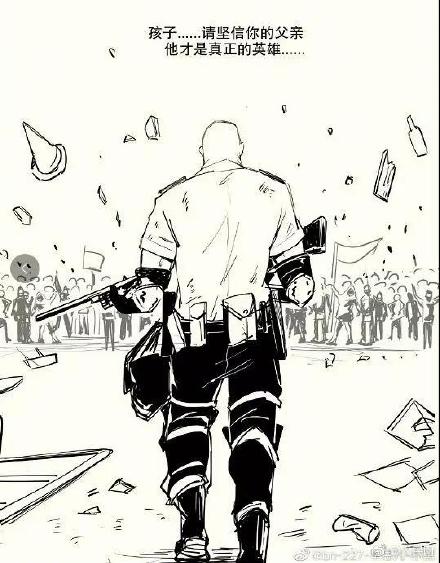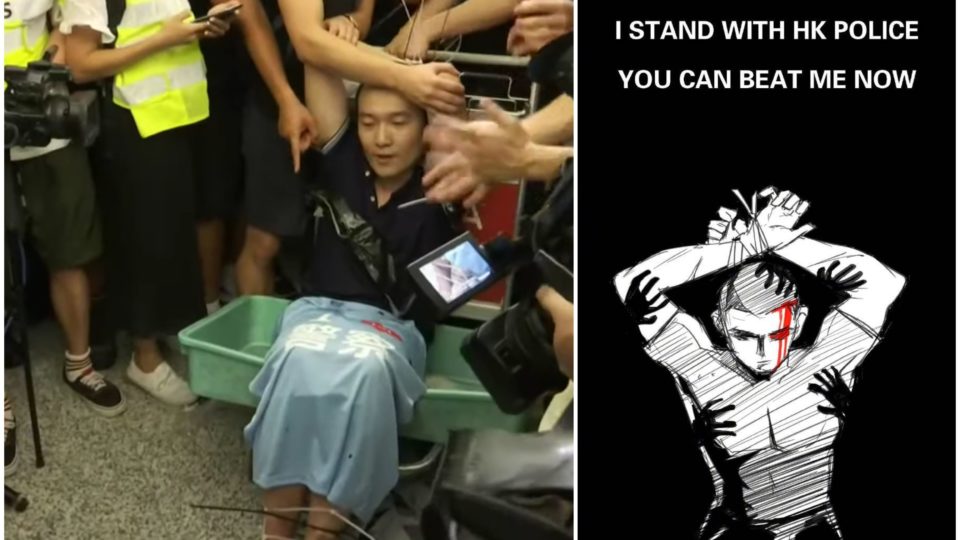China reacted furiously today to what it described as “terrorist-like” attacks on its citizens by pro-democracy protesters at Hong Kong’s airport, as state media and pro-Beijing netizens seized on the ugly scenes of chaos to fuel a counter-narrative to protesters’ message of self-determination in the face repression.
The rallies, which had paralyzed one of the world’s busiest travel hubs, ended with ugly clashes last night that included protesters beating two men suspected of being “spies.” The Chinese government immediately seized on the attacks to louden its drumbeat of anger and intimidation against the protesters, who have staged 10 weeks of relentless rallies to demand greater freedoms.
“We express the strongest condemnation of these terrorist-like actions,” said Xu Luying, spokeswoman at the Hong Kong and Macao Affairs of the State Council, who called the two men who were beaten “mainland China compatriots.”
It was the second time this week that China has sought to frame the protests as “terrorism,” part of a pattern of increasingly ominous warnings that have raised fears it may deploy force to quell the unrest.
The characterization was echoed by China’s liaison office in Hong Kong, which said in a statement today that the “atrocity has totally gone beyond the bottom line of a civilized society, which is no different from terrorists’ acts,” according to the state-run China Daily.
“This time the protesters have torn down their deceptive masks of ‘peace, rationality and non-violence,’” the statement added.
Other state-backed media have reliably amplified the terrorism narrative, with the Global Times saying in an op-ed yesterday that “Hong Kong’s recent protests and riots have shown obvious characteristics of a color revolution.”
These rioters’ acts perfectly match Wikipedia’s definition of terrorism: “Terrorism is, in the broadest sense, the use of intentional violence, generally against civilians, for political purposes.”
The protesters, who are demanding that China’s rulers stop interfering in the city, have enjoyed widespread support throughout most sectors of Hong Kong’s society. But the beating of the two men at the airport, as well as the blocking of passengers from boarding flights, could backfire in terms of maintaining support, and has prompted soul searching among the protesters’ camp about whether the actions crossed a line.
https://twitter.com/jgriffiths/status/1161252153245216773?s=20
The first man — who was identified as a traveler by Hong Kong officials and Chinese media, but accused of being an undercover Shenzhen policeman by protesters — was held for about two hours and assaulted before eventually being led away in an ambulance.
Riot police briefly deployed pepper spray and batons to beat back protesters while they escorted the ambulance away from the departures hall.
Another man, wearing a yellow journalist vest, was surrounded, zip-tied, and beaten by a small group who accused him of being a spy.
The man was later confirmed to be a staffer for the Global Times, which has vociferously condemned the protests.
https://twitter.com/JeromeTaylor/status/1161309234052521984
Perhaps unsurprisingly, the paper was quick to weigh in against the assault, saying in an op-ed today that “no excuse can exonerate [protesters] of the blame for violent crimes.”
“Any attempt, especially by some biased Westerners, to defend them is nothing short of being an accomplice in the violence,” the op-ed adds.
The piece’s author incredulously notes that the staffer, named Fu Guohao, had been beaten after protesters found an “I Love Hong Kong” T-shirt in his bag — without acknowledging that the shirt was also seen on groups of men accused of assaulting protesters during another protest a little over a week ago.
https://twitter.com/madeinhomekong/status/1158422521122701312
In a separate story, the tabloid noted that “Fu Guohao” had become a trending topic on the social media site Sina Weibo, while also noting how Fu “fearlessly” stated “I support Hong Kong police, you can beat me now” after being detained, at which point he was “set upon” by the protesters.
https://twitter.com/cader666k/status/1161315045566898176
Social media was soon aflutter with the slogan, with users — at least some of whom appeared to be bots — repeating the words in affirmation of their solidarity with Fu and in opposition to the Hong Kong protests.
One widely distributed image also included the message “What a shame for Hong Kong.”
Fu even received the meme treatment, with some users creating illustrations of him, hands bound, stoically uttering the phrase as disembodied black hands grasp at him.
https://twitter.com/jsnj18/status/1161505754676961280?s=20
The images were reminiscent of many of the eye-catching posters and fliers generated and widely shared by Hong Kong’s protesters — as well as of other images widely circulated on the mainland that have similarly lionized those perceived as opposing the movement.
When a Hong Kong police officer drew international attention for pointing a shotgun — loaded with bean bag rounds — at protesters after being swarmed and knocked to the ground, he similarly became an emblem of stalwart establishmentarianism to mainland netizens, with state media promoting the trend.

Characterizations of the violence in a story on the response to Tuesday’s incident, meanwhile, were unsurprisingly dire.
“They were mad and crazy and were carried away by violence. No matter what their motivations were, the act of violence is unacceptable,” Li Xiaobing, an academic from Nankai University in Tianjin, was quoted as saying in the Global Times.
Another academic also quoted in the piece “urged Hongkongers who wish to maintain the rule of law to make their voices heard or otherwise they will be held historically accountable for the fall of the city.”




